

"Peru was a key cradle of civilization along the Andes, and different cultures mixed and boomed in the area," Zhao says. "We want to show how ancient Peruvians lived through the collection of artifacts."
To better explain a remote civilization to the Chinese public, animal patterns on the artifacts are highlighted to provide hints.
For example, worship of felines as totems can be seen in the artifacts from the Chavin Culture from 1300 to 200 BC. Even a ceramic bottle with a human facial decoration has had a pair of buckteeth added to resemble a jaguar.
As Zhao points out, the Chavin Culture represents the first peak of Andean civilization. Many of its features like jaguar worship and large-scale ceremonial centers continued to appear throughout subsequent cultures.
Its fall also marks a long epoch, witnessing rise of various cultures in different regions.
In the Nazca Culture, which lasted roughly from 100 BC to AD 700, orcas were treated like a god. In its mythology, the orca-deity was responsible for taking beheaded prisoners of war to the underworld and thus feed people's ancestors. While in the Moche Culture, lasting from 250 to 750, deer was considered to connect people with the souls of their ancestors, while the magnificent Andean condor also played a key role in its belief system. These traditions are reflected through the exquisite artifacts on display.